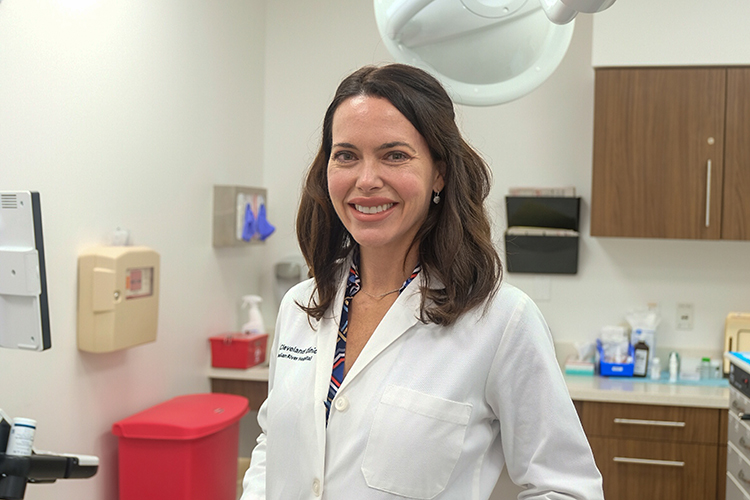
Any cancer diagnosis is a heavy blow, but head and neck cancer presents problems and complications that are especially fearsome. Not only are there concerns about the removal of the cancer, but there is a whole other issue about the impact treatment will have on the patient’s appearance and ability to swallow, speak and even breathe properly.
Since most cancerous tumors of the head and neck cannot be treated without surgical excision, patients are often left with devastating functional and cosmetic defects. That is because many otolaryngologists (surgeons specializing in head and neck surgery) can remove cancerous tumors, but only a specialized few have the training and ability to successfully reconstruct the affected area.
And now Vero Beach has one of those specialized few.
Up until this summer, head and neck cancer patients in Vero had to travel to a major academic center in Miami, Tampa or Gainesville to get high-quality reconstructive surgery, but the recent addition of Dr. Ashley Mays to the oncology team at Cleveland Clinic Indian River Hospital changes that. Now, these patients can stay close to home while undergoing the complex surgery and reconstruction process.
“The critical piece that I bring to the department is my ability to perform microvascular flap surgery for facial reconstruction,” Dr. Mays said “Microvascular flap surgery is treating patients with a transplant. It’s really not so different than a heart or lung transplant, as we remove tissue from one part of the body and place it in another part of the body. The difference is that it comes from the same person – the patient himself.
“I transplant tissue from the lower leg, thigh or arm and use that tissue along with their defined vasculature to reconstruct whatever defect there is in the head and neck.
“For example, if someone is missing a portion of their jaw and tongue because of the resection necessary to remove the tumor, I can take a piece of bone and skin from their lower leg and use that to reconstruct the jaw.
“We now have the technology that enables me to virtually preplan the bony reconstruction surgery with my cuts so that when I go to the leg and harvest that donor bone, I can make very precise cuts in the leg. Because of this, when it comes up to the head and I’m putting in plates and screws, it is a very close replica to how their natural jaw was.”
Dr. Mays explained that the mapping process is done through an industry website that creates a model she uses to match cuts at the donor site.
“If I am going to take out 4 centimeters of jaw on the left side, then I can preplan the angles and cuts of that layered projection and mark those out on the tibia site. It’s all part of creating a near native anatomy and trying to create a functional piece of tissue.
Preplanning the cuts and angles helps put things back together more smoothly. Not only do we have an obligation to create a very functional outcome, but we try to create as much aesthetic and pre-morbid reconstruction as possible.”
The degree of functionality after reconstruction depends upon the extent and location of the surgery. If, for example, someone is missing a larynx after throat reconstruction, they will not be able to regain speech but they will be able to swallow. If a tongue needs to be reconstructed, the patient’s ability to taste will be directly proportionate to the amount of tissue taken from the tongue. Patients undergo very in-depth speech and swallowing therapy evaluation and therapists assist them in achieving the best possible results.
In most cases the reconstruction surgery is done at the same time as the tumor is removed.
Free flap surgery patients will stay at least a week in the hospital to make sure the transplant heals and survives. Up to 2 percent of the time there will be some kind of event with vascular issues during their hospital stay, but since they are already hospitalized the physician can quickly address the problem. Only 1 percent of patients will have failure of their reconstruction. When that occurs, there are methods to do another free flap procedure or some other kind of reconstruction.
Another piece of the puzzle is closing the harvest site of the tissue. Depending on the area it’s taken from, the surgeon is usually able to sew it back together. In situations where that is not feasible, the doctor may take a skin graft from a different part of the body to patch the harvest area.
“The head and neck are extraordinarily complicated organs and we have to do complex organ-specific reconstruction” Dr. Mays said. “What differentiates our hospital from others is that we now have the ability and expertise to perform complex reconstructive surgery in addition to high level ablative surgery making it a one-stop shop. There is basically no surgery that we can’t do here at Cleveland Clinic Indian River Hospital.”
Dr. Mays received her medical education at the Brody School of Medicine at East Carolina University in Greenville, North Carolina, and completed her otolaryngology residency at Wake Forest University, in Winston-Salem, North Carolina.
She completed a two-year fellowship in Head and Neck Surgical Oncology and Total Body Microvascular Reconstruction at University of Texas MD Anderson Cancer Center in Houston. Her office is located in the Scully Welsh Cancer Center, 3555 10th Court, Vero Beach. Call 772-770-6830 to schedule an appointment.



